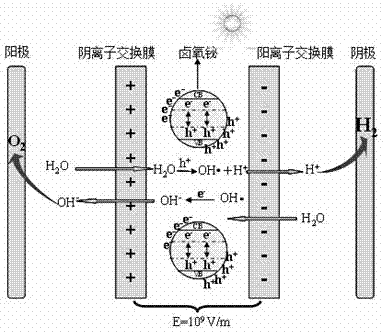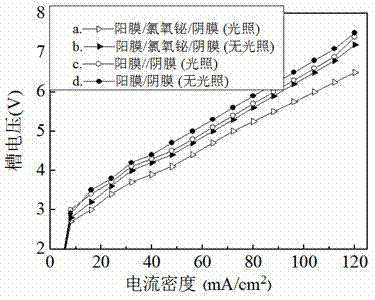Preparation of photoelectric catalytic membrane for preparing hydrogen by decomposing water
A technology for photoelectric catalysis and water splitting, applied in organic compound/hydride/coordination complex catalysts, physical/chemical process catalysts, diaphragms, etc.
- Summary
- Abstract
- Description
- Claims
- Application Information
AI Technical Summary
Problems solved by technology
Method used
Image
Examples
Embodiment approach 1
[0031] The preparation method of a photoelectric catalytic film for decomposing water to produce hydrogen is as follows.
[0032] (1) Weigh 2.0 g of sodium cellulose acetate and 3.0 g of polyvinylpyrrolidone and mix them in a beaker, heat and stir to dissolve with distilled water, cast on a flat glass plate, dry in an oven at 20°C to form a film, and then use heavy metals Ion Ti 4+ Cross-link for 5 minutes, and then use the -PO 4 The solution is soaked for 5 minutes and dried at room temperature; a positive film with a thickness of 50 μm is obtained.
[0033] (2) Weigh 0.1 g of bismuth oxychloride catalyst uniformly dispersed in absolute ethanol under ultrasonic vibration, pour it on the surface of the positive film obtained in step (1) above, and air dry at 20°C to obtain a bismuth oxychloride film with a thickness of 0.05μm .
[0034] (3) Weigh 2.0 g of chitosan and 3.0 g of polyvinylpyrrolidone and mix them in a beaker, heat and stir to dissolve with 0.25% acetic acid aqueous...
Embodiment approach 2
[0038] The preparation method of a photoelectric catalytic film for decomposing water to produce hydrogen is as follows.
[0039] (1) Weigh 3.0 g sodium carboxymethyl cellulose and 4.0 g polyvinylpyrrolidone and mix them in a beaker, heat and stir to dissolve with distilled water, cast on a flat glass plate, dry in an oven at 25°C to form a film, and then Using heavy metal ion Ti 4+ Cross-link for 10 minutes, then use -PO 4 Soak the solution for 10 minutes and dry at room temperature to obtain a positive film with a thickness of 50 μm.
[0040] (2) Weigh 0.3 g of bismuth oxychloride catalyst uniformly dispersed in absolute ethanol under ultrasonic vibration, pour it on the surface of the positive film prepared in step (1) above, and air dry at 25°C to obtain a bismuth oxychloride film with a thickness of 0.05μm .
[0041] (3) Weigh 3.0 g of chitosan and 4.0 g of polyvinylpyrrolidone and mix them in a beaker, heat and stir to dissolve with 0.5% acetic acid aqueous solution, add g...
Embodiment approach 3
[0045] The preparation method of a photoelectric catalytic film for decomposing water to produce hydrogen is as follows.
[0046] (1) Weigh 5.0 g of sodium cellulose acetate and 6.0 g of polyvinylpyrrolidone, mix them in a beaker, heat and stir to dissolve with distilled water, cast on a flat glass plate, dry in an oven at 30°C to form a film, and then use heavy metals Ion Ti 4+ Cross-link for 15 minutes, then use -HSO 3 Soak the solution for 15 minutes and dry at room temperature to obtain a positive film with a thickness of 50 μm.
[0047] (2) Weigh 0.5 g of bismuth oxybromide catalyst uniformly dispersed in absolute ethanol under ultrasonic vibration, pour it on the surface of the positive film prepared in step (1) above, and air dry at 30°C to obtain a bismuth oxybromide film with a thickness of 0.05μm .
[0048] (3) Weigh 5.0 g of chitosan and 6.0 g of polyvinylpyrrolidone, mix them in a beaker, heat and stir to dissolve with 0.75% acetic acid aqueous solution, add succinal...
PUM
| Property | Measurement | Unit |
|---|---|---|
| thickness | aaaaa | aaaaa |
| thickness | aaaaa | aaaaa |
| thickness | aaaaa | aaaaa |
Abstract
Description
Claims
Application Information
 Login to View More
Login to View More - R&D
- Intellectual Property
- Life Sciences
- Materials
- Tech Scout
- Unparalleled Data Quality
- Higher Quality Content
- 60% Fewer Hallucinations
Browse by: Latest US Patents, China's latest patents, Technical Efficacy Thesaurus, Application Domain, Technology Topic, Popular Technical Reports.
© 2025 PatSnap. All rights reserved.Legal|Privacy policy|Modern Slavery Act Transparency Statement|Sitemap|About US| Contact US: help@patsnap.com



